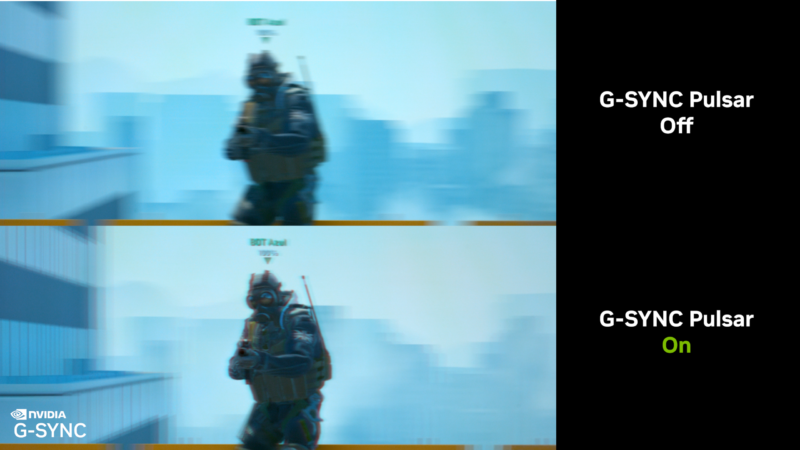What will they sync of next? —
Branded monitors can sync pixels to backlighting, refresh rate, and GPU frames.
Kevin Purdy
– Jan 9, 2024 5:10 pm UTC

Enlarge / None of this would be necessary if it weren’t for your inferior eyes, which retain the colors of pixels for fractions of a second longer than is optimal for shooting dudes.
Nvidia
Gaming hardware has done a lot in the last decade to push a lot of pixels very quickly across screens. But one piece of hardware has always led to complications: the eyeball. Nvidia is targeting that last part of the visual quality chain with its newest G-Sync offering, Pulsar.
Motion blur, when it’s not caused by slow LCD pixel transitions, is caused by “the persistence of an image on the retina, as our eyes track movement on-screen,” as Nvidia explains it. Prior improvements in display tech, like variable rate refresh, Ultra Low Motion Blur, and Variable Overdrive have helped with the hardware causes of this deficiency. The eyes and their object permanence, however, can only be addressed by strobing a monitor’s backlight.
You can’t just set that light blinking, however. Variable strobing frequencies causes flicker, and timing the strobe to the monitor refresh rate—itself also tied to the graphics card output—was tricky. Nvidia says it has solved that issue with its G-Sync Pulsar tech, employing “a novel algorithm” in “synergizing” its variable refresh smoothing and monitor pulsing. The result is that pixels are transitioned from one color to another at a rate that reduces motion blur and pixel ghosting.
Nvidia also claims that Pulsar can help with the visual discomfort caused by some strobing effects, as the feature “intelligently controls the pulse’s brightness and duration.”
The featureless axis labels make my brain hurt, but I believe this chart suggests that G-Sync Pulsar does the work of timing out exactly when to refresh screen pixels at 360 Hz.
Nvidia
The same, but this time at 200 Hz.
Nvidia
And again, this time at 100 Hz. Rapidly changing pixels are weird, huh?
Nvidia
To accommodate this “radical rethinking of display technology,” a monitor will need Nvidia’s own chips built in. There are none yet, but the Asus ROG Swift PG27 Series G-Sync and its 360 Hz refresh rate is coming “later this year.” No price for that monitor is available yet.
It’s hard to verify how this looks and feels without hands-on time. PC Gamer checked out Pulsar at CES this week and verified that, yes, it’s easier to read the name of the guy you’re going to shoot while you’re strafing left and right at an incredibly high refresh rate. Nvidia also provided a video, captured at 1,000 frames per second, for those curious.
Nvidia’s demonstration of G-Sync Pulsar, using Counter-Strike 2 filmed at 1000 fps, on a 360 Hz monitor, with Pulsar on and off, played back at 1/24 speed.
Pulsar signals Nvidia’s desire to once again create an exclusive G-Sync monitor feature designed to encourage a wraparound Nvidia presence on the modern gaming PC. It’s a move that has sometimes backfired on the firm before. The company relented to market pressures in 2019 and enabled G-Sync in various variable refresh rate monitors powered by VESA’s Display port Adaptive-Sync tech (more commonly known by its use in AMD’s FreeSync monitors). G-Sync monitors were selling for typically hundreds of dollars more than their FreeSync counterparts, and while they technically had some exclusive additional features, the higher price points likely hurt Nvidia’s appeal when a gamer was looking at the full cost of new or upgraded system.
There will not be any such cross-standard compatibility with G-Sync Pulsar, which will only be offered on monitors with a G-Sync Ultimate badge, and then further support Pulsar, specifically. There’s always a chance that another group will develop its own synced-strobe technology that could work across GPUs, but nothing is happening as of yet.
In related frame-rate news, Nvidia also announced this week that its GeForce Now game streaming service will offer G-Sync capabilities to those on Ultimate or Priority memberships and playing on capable screens. Nvidia claims that, paired with its Reflex offering on GeForce Now, the two “make cloud gaming experiences nearly indistinguishable from local ones.” I’ll emphasize here that those are Nvidia’s words, not the author’s.
>>> Read full article>>>
Copyright for syndicated content belongs to the linked Source : Ars Technica – https://arstechnica.com/?p=1994572































